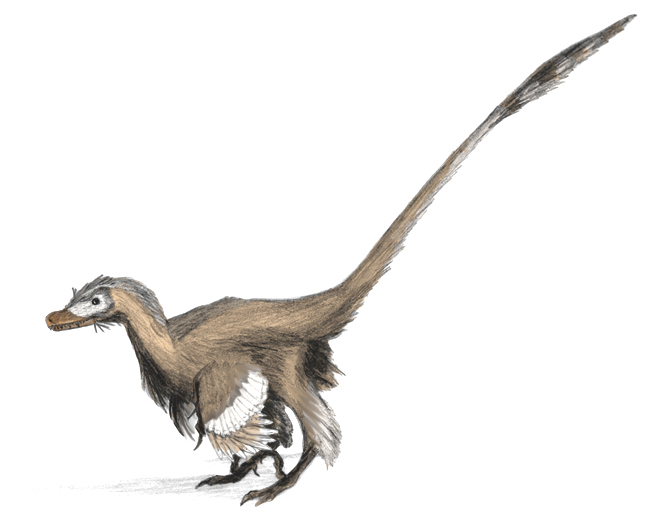Part 4 of 4 of my D-cember: Dino-cember! series
My Disclaimer: This post covers dinosaur evolution, and I apologize in advance for my (rather incomplete) knowledge of evolution and the evolutionary sciences, but I do know that, evolution, as phrased in Stephen Jay Gould’s essay “Scalia’s Misunderstanding” (p. 448 of the previously mentioned Bully for Brontosaurus) is not:
Evolution is not the study of life’s ultimate origin as a path toward discerning its deepest meaning. Evolution, in fact, is not the study of origins at all. Even the more restricted (and scientifically permissible) question of life’s origin on our earth lies outside its domain. (This interesting problem, I suspect, falls primarily within the purview of chemistry and the physics of self-organizing systems.) Evolution studies the pathways and mechanisms of organic change following the origin of life.
—Stephen Jay Gould, “Scalia’s Misunderstanding“
The when and what and the how of hereditary changes, for example the theropods (suborder Theropoda, from Greek, meaning “beast feet,” a broad category encompassing all bipedal-running carnivores like T. Rex and Velociraptor) or… more specifically, maniraptoran (“thieving/snatching hands” or “raptor hand”) dinosaurs becoming birds, these are the study of evolution’s main points of inquiry.
Mesozoic Mysteries
My questions are: why did some landlocked dinosaurs evolve feathers, while their airborne cousins, the pterosaurs—the first flying vertebrates—did not? Why would flightless bipedal predators like Deinonychus and Microraptor (and their other raptor descendants) develop feathers instead of pterosaur-style fur-like pycnofibre coats? Basically, what is the evolutionary advantage of feathers vs. pycnofibres if you’re a theropod?
First, the issue of maniraptoriforme dinosaurs (trying to use a broad category for all the raptory dinos close to birds, though it is likely I’m using the wrong one).
Yale paleontologist John Ostrom unearthed Deinonychus from Montana in 1964, and though Deinonychus wasn’t the first raptor described, Ostrom’s detailed monograph on the specimen (published in 1968) provided the clearest evidence yet that bird-like theropods existed, and shed new light on dinosaurs. Deinonychus was obviously built for speed and speedily tearing prey, their scary claws inspired the Greek name Deinonychus (“terrible claw”), and, along with their big brains and eyes, did not match up with the prevailing view of dinosaurs as fairly slow, cold-blooded cousins of crocodiles. What I call the warm-blooded birdosaur theory, proposed by Thomas Henry Huxley in 1868 along with his observations about Archaeopteryx (the small, bird-like dino “transitional species” found in 1861, “intermediate between birds and reptiles”), was revived thanks to Ostrom’s work. His work on the similarities between Deinonychus and Archaeopteryx put the theory on such solid ground, few try to disprove that “some dinosaurs were warm-blooded.” And subsequent discoveries established it so well, warm-bloodedness is hardly doubted nowadays even in lumbering herbivores like Stegosaurus Stenops.
Viewing dinosaurs as bird-like endotherms (animals that create their own heat via metabolic processes, AKA “warm-blooded”) was a big breakthrough, re-shuffling the family tree so all birds are derived from dinosaurs, and broadening what are considered “reptiles.” And it also allows dinosaurs to make sense. For example, the height of a brontosaur‘s neck would break the laws

of biological possibility for an ectothermic (cold-blooded) creature with the limitations of a reptilian circulatory and respiratory system, but could be possible (though still “redonkulous”) with a powerful, avian-type of cardiopulmonary system. Likewise, understanding how pterosaurs vaulted themselves into the air and then sustained the movements of powered flight for extended periods is near-impossible assuming ectothermic metabolisms, especially considering the biggest, giraffe-sized pterosaur species, but begin to make sense for an endothermic creature.
Ornithological Explorations
When I say “subsequent discoveries” confirmed the birdosaur theory, I’m referring to the series of fossil “transitional species,”or more informally, “dino-birds,” that have been found in the late ’90s and throughout the ’00s up through today, mostly in China and environs. A surprising number of these seriously freaky-deaky species, Archaeopteryx-like “dino-birds,” have been identified and studied in recent years.
Insofar as a species can be freaky-deaky, these “dino-birds” are… though in my opinion, plenty of existing species fall into the freaky category: turkeys, vultures and ostriches from the birdosaur lineage, bats who arrived at scary, pterosaur-like wings independently, etc. But I guess if you’re a member of one of the aforementioned species, you don’t seem so freaky.
Xiaotingia

First described in 2011, Xiaotingia zhengi is the closest relative of Archaeopteryx found so far, and one of the basalmost (earliest, most “basal,” preferred over the term “most primitive” since later stages of evolution aren’t necessarily “better”) “transitional species” identified to date, more basal than Archaeopteryx. Like Archaeopteryx itself, the phylogenetic categorization is murky indeed: it’s debatable whether Xiaotingia counts as a straight-up bird (“early avian species”) or an “intermediate species” (dino-bird) somewhere amongst the roots of what became the bird family tree (the class Aves). Its dino characteristics exist mostly in certain non-avian skeletal features, not in visible form (excepting the long, bony, maniraptoriforme tail).
Graciliraptor

Described in 2004, Graciliraptor is considered closely related to freaky four-winged dino-bird Microraptor, so it’s considered a microraptorian, an even more narrow category than Maniraptoriformes, that includes the smallest, closest dino relatives of birds.
Tianyuraptor

Tianyuraptor. Really bizarre and amazing dino-chicken Tianyuraptor ostromi (named in honor of John Ostrom).
Velociraptor

In September 2007, researchers found “quill knobs” on the forearm of a Velociraptor found in Mongolia. These bumps on bird wing bones show where feathers anchor. This, along with other finds, including multiple discoveries of fossil feathers with these ‘raptors, proved that later raptory theropods often had feathers, strengthening Ostrom’s birdosaur theory even further
and rendering Spielberg’s scaly Jurassic Park velociraptors (and NBA team Toronto Raptors‘ velociraptor logo) inaccurate.
Why feathers?
Why would some theropods, landlocked carnivores in an environment of ferocious dino-eat-dino competition, evolve feathers? Why would the development of feathers make the evolutionary to-do-list for these predatory dinosaurs who needed to devote all the biological resources they could accrue to gain an edge in the game of kill-or-be-killed? This is especially puzzling when one considers pterosaurs’ featherless physique; now that we know more about pterosaur evolution, it’s clear that their fuzzy, partial pycnofibre coats weren’t helpful for flying and bore no resemblance to proto-feather layers. We can conclude the weird partial coats of pycnofibres (which kind of remind me of humans’ internal cilia) were sufficient for pterosaurs’ thermoregulatory needs and feathers weren’t crucial to being a flying predator. Additionally, pterosaur evolution was so radically different from all other archosaurs, they must’ve split from the herd very early in their development.
Predatory raptors, under intense evolutionary pressures constantly (driven by climate change, ecological shifts disrupting the food chain, plus fearsome competition for prey with other predatory species),

wouldn’t’ve invested evolutionary/mutagenic energies into feathers unless out of necessity, so I tend to view their feathering-up as a thermoregulatory aid, essential for smaller species (microraptorians for example) that are especially vulnerable to heat loss. Eventually, climate swings into colder temperatures may have wiped out featherless theropods while feathered species survived, or perhaps a time period of the only sustainable sources of prey being in cold parts of Earth disadvantaged featherless predators, or something far more complicated, but somehow feathers gave enough benefit that they continue in the gene pool from at least the Late Jurassic to today.
In Dinosaurs: A Very Short Introduction, the author, British ornithologist and natural historian David Norman, described proto-feathers as beginning for heat-conservation purposes, but suggested the development of “genuinely bird-like flight feathers,” and perhaps bird flying itself, originated as byproducts of their primary function – mating displays:
…so small, active endotherms would be expected to insulate their bodies to reduce heat loss. Small theropod dinosaurs, therefore, evolved insulation to prevent heat loss because they were endotherms -not because they ‘wanted’ to become birds!
Liaoning discoveries indicate that various types of insulatory covering developed, most probably by subtle modifications to the growth patterns of normal skin scales; these ranged from hair-like filaments to full-blown feathers. It may well be that genuinely bird-like flight feathers did not evolve for the purposes of flight, but had a far more prosaic origin. Several of the ‘dinobirds’ from Liaoning seem to have tufts of feathers on the end of the tail (rather like a geisha’s fan) and fringes of feathers along the arms, on the head, or running down the spine. Clearly preservational biases may also play a part in how and on which parts of the body these may be preserved. But for the present, it seems at least possible that feathers evolved as structures linked to the behaviour of these animals: providing recognition signals, perhaps, as in living birds, or being used as part of their mating rituals, long before any genuine flight function had developed.
In this context, gliding and flight, rather than being the sine qua non of avian origins, become later, ‘add-on’ benefits. Obviously, feathers have the potential for aerodynamic uses; just as with modern birds, the ability to jump and flutter may well have embellished ‘dinobird’ mating displays. For example, in the case of the small creature Microraptor, a combination of fringes of feathers along the arms, legs, and tail would have provided it with the ability to launch itself into the air from branches or equivalent vantage points. From just this sort of starting point, gliding and true flapping flight seem a comparatively short ‘step’ indeed.
© David Norman, Dinosaurs: A Very Short Introduction
For more on this source, see its section of veryshortintroductions.com
It’s kind of romantic if you think about it, devoting millions of years in order to move from carpet-esque proto-feather fuzz to a covering with more “bling,” to impress a mate.

It also underscores how features often evolve in animals in indirect and unexpected ways.
In another unexpected quirk of evolution, the dating of dino-bird specimens, even basal “intermediate species” like Xiaotingia, and oldest, basal microraptorians like Sinornithosaurus, shows they were around after, and coexisted with early avians. That freaky dino-birds like Sinornithosaurus rubbed elbows with ducks, ostriches, quail, turkeys, etc. means birds “spun-off” from an earlier common ancestor, likely an even more basal microraptorian during the Jurassic period.
Think of Aves (the class containing all of today’s birds) as a TV show spin-off, but a spin-off that lasts much longer than the older show it branched-off from, like The Simpsons, which was originally a segment on The Tracey Ullman Show, was spun-off as its own series, coexisted on the TV schedule with The Tracey Ullman Show for multiple seasons but ultimately outlived its ancestor and keeps going and going up to today. Similarly, Aves spun-off from the dino-bird show, coexisted on the Mesozoic schedule, living side-by-side throughout the Cretaceous, but the dino-bird show got canceled via the big, horrendous kablooie, the Cretaceous-Paleogene extinction event, and along with an estimated three-quarters of plant and animal species on the planet, didn’t live to see the Cenozoic (the consensus is still that something bad collided with the Earth). Somehow, Aves kept going and going, with nearly all its cast intact.
Nick
thus ends the big Dinocember series (though I may do a bonus post on pterosaurs and a quick note on stegosaurs)
For the other dinosaur-posts in my D-cember: Dino-cember! series, go to:
Part 3: Brontosaurus, you shan’t be forgotten
Part 2: Tananim Gedolim: “great reptiles,” the dinosaurs in the Torah (somewhat controversial)
Part 1: The Griffin Was Based On A Real Creature! (#1 most-visited page on nickscrusade.org, by far)
Note: I wanted to add the infamous Alabama State Board of Education “biology textbook insert” evolution disclaimer at the top of this post, but it is too long. The revised disclaimer seems 30-40% longer than than the original 1996 sticker I confronted in high school, though it’s still written in the same clunky, dense committee-ese that proved indecipherable for even the most bold, intrepid minds back then, so is skipped so thoroughly that few students could tell you it’s there. Read the 2001 “biology textbook insert” here if you’re in need of an insomnia cure.
